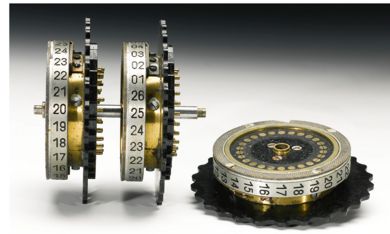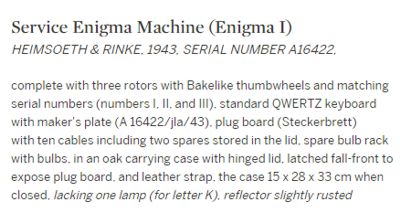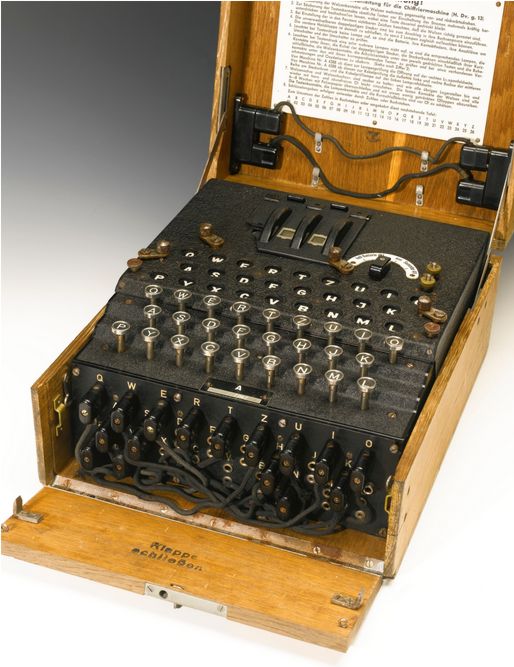| Another Three-Rotor Enigma Machine Up For Auction |
| Written by Historian | |||
| Monday, 13 July 2015 | |||
|
Three-rotor Enigma machines are considered rare, but they turn up at auction at a rate of around one per year. Sotheby's has one in its sale on 14th July that might easily be overlooked as it is included in a sale billed as being English Literature, History, Children Books & Illustrations.
OK, an Enigma machine does count as History, even though they more often turns up in sales devoted to memorabilia or to scientific artifacts. This one is an Enigma 1, one of the enciphering machines used to pass coded German messages during the Second World War, manufactured in 1943 and whose codes were broken by Alan Turing and the Bletchley Park codebreakers.
Sotheby's describes it as an "exceptionally well-preserved example", and provides an estimate of £50,000 to 70,000 (USD 76,885 to 107,639). This seems a bit on the low side given that one of a similar condition auctioned by Bonhams in London in November 2012 fetched £85,000 (see Rare Three-Rotor Enigma Machine Up For Auction), In September 2011 an Enigma 1 dated circa 1939 which was used in the 2001 film Enigma fetched £133,250 ($208,137) and in April 2015 a 1944 machine, in working order in its original oak box sold for £183,930 ($269,000). This was at the same Bonham's sale in New York at which an Alan Turing notebook was sold for $1.025 million. An Enigma machine was also seen in the recent film starring Benedict Cumberbatch about Alan Turing and the codebreaking activities at Bletchley park. Although this isn't the one used in the film, until now it was part of a European Museum collection, the film has attracted popular attention, which might push up the bidding. The Condition Report for Lot 55 states:
The catalog notes also provide a good account of how the machine was used: The function of the machine was simply to substitute an inputted letter in a manner that would make it as hard as possible to work out what the original letter had been. Its basic mechanism can be fairly easily understood. The user takes the first letter of his plain text message and keys it into the keyboard (“G”, for example). Pressing the key completes an electrical circuit and lights up one of the letter lamps on the lamp-board (e.g. "H"): the complexity comes in the passage of the electrical signal. The signal travels first to the plugboard, which has a plug for each letter so if the machine is configured with a cable on the input letter then the signal is diverted (“G” here being substituted for “L”). Then the signal travels up to the rotors. There are three moveable rotor wheels (each of which has 26 positions) on the standard army Engima, together with a reflector on the far left. As the signal passes through each wheel it goes through another substitution and the reflector both enacts another substitution and then sends the signal back through the rotors a second time, so in this case the “L” is transformed seven times before coming as an output which finally lights the lamp at “H”, which is then written down by the operator as the first letter of their enciphered message. Pressing a key also mechanically pushes at least one of the rotor wheels (and possibly more, depending on the configuration) on one step, so if “G” was pressed a second time the signal would reach a different light. Furthermore, not only could the plugboard be configured in different way, and not only could each of the individual wheels begin a message at any one of their 26 settings, but the wheels were themselves removable and could be put in any order or exchanged for different wheels altogether (the standard army Enigma had a choice of five wheels). The sequence of wheels was changed daily. So whilst the machine would always perform the same conversion with the same setting, overall there were a total number of 159 million million million possible daily keys.
In referring to the way in which the Enigma code was broken, the notes refers to the contribution of the Polish cryptographers who had begun to decrypt Enigma traffic before the war as well as the work done at Bletchely Park that is now recognized as having shortened the Second World War by as much as two years.
More InformationService Enigma Machine in Sotheby's Catalog Related ArticlesRare Three-Rotor Enigma Machine Up For Auction Campaign for Recognition of Polish Enigma Codebreakers Alan Turing Notebook To Be Auctioned
To be informed about new articles on I Programmer, install the I Programmer Toolbar, subscribe to the RSS feed, follow us on, Twitter, Facebook, Google+ or Linkedin, or sign up for our weekly newsletter.
|
|||
| Last Updated ( Monday, 26 August 2024 ) |



